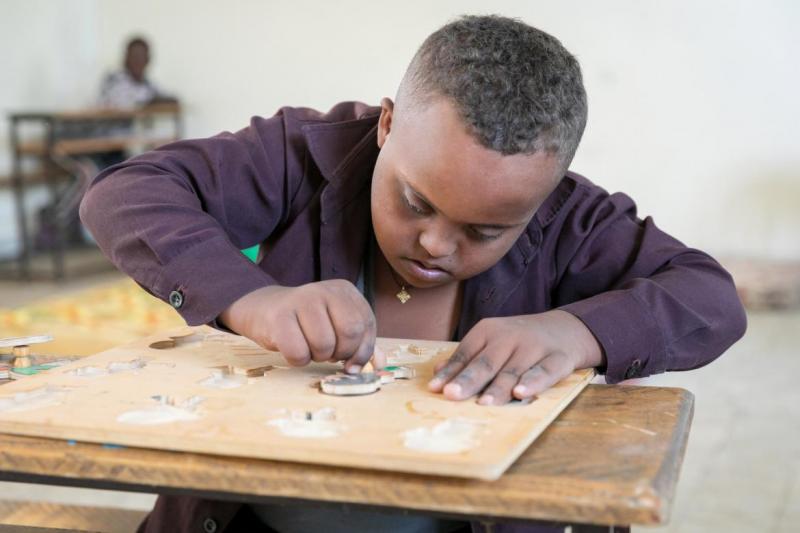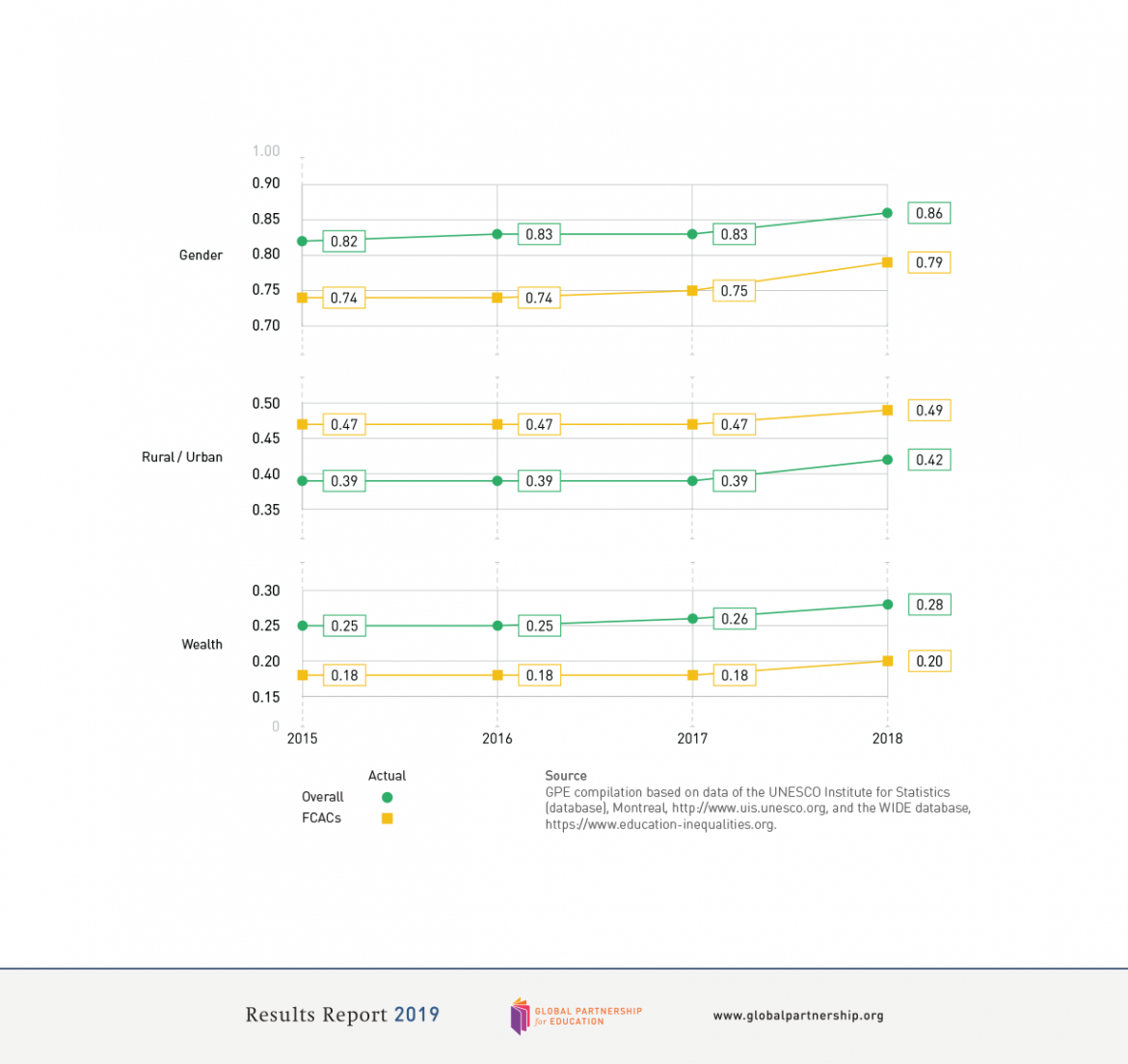
Tackling inequalities and exclusion in education are fundamental parts of GPE’s mission and the Sustainable Development Goals. Almost one in five children remain out of school at primary age in GPE partner countries, and among those going to school there are vast disparities in learning outcomes.
GPE support for equity and inclusion
Ensuring that all children have equal opportunities to access a quality education requires action at the global and national levels. At the global level, GPE has supported research and projects on out-of-school children, disability and health, and school-related gender-based violence. In partner countries, GPE promotes equity through its support for education sector planning and funding model. Countries have to allocate sufficient domestic funding, especially to primary education, in order to be eligible for GPE funding, and GPE’s results-based model requires that countries demonstrate results in equity and inclusion to receive their full allocation of funds. GPE’s Results Report 2019 finds that among the 34 implementation grants active as of June 2018, US$372.8 million in GPE funding supported activities to improve equity and inclusion.
Nonetheless, stark and persistent inequalities in many countries. As the Results Report highlights, children from the poorest households, from rural areas, and from countries affected by fragility and conflict are still more likely to be left behind, as are girls. Children from the richest 20% of households are more than three times more likely to complete lower secondary school than those from the poorest 20 percent, and in fragile and conflict affected countries the gaps are even larger (see graph below). These disparities become even more substantial in combination, and in most countries, rural girls from the poorest households are the furthest behind.
Parity indices across GPE DCPs with regard to gender, location and wealth.
 Parity indices across GPE DCPs with regard to gender, location and wealth
Parity indices across GPE DCPs with regard to gender, location and wealth
In many countries, the more socioeconomically advantaged children end up capturing the bulk of public education expenditures. This is one of the many reasons why efficiency, equity and efficacy are intertwined when it comes to strong education systems, and why GPE pursues these goals jointly in its model supporting system strengthening.
Equity in education is well recognized in sector planning, but the response rarely matches the scale of the problem. GPE’s country-level evaluations revealed that recent education sector plans generally pay attention to educational disparities. But several do not address equity issues in enough detail or consistency, and most do not present an achievable plan for implementation. Many countries have introduced or expanded measures to expand access for out-of-school children, but these are often rolled out at relatively small scale and will require “require substantial further investment to likely have system-wide effects.”
Knowledge and innovation to ensure no one is left behind
Tackling disadvantage needs to be a central focus of national education plans and high among global priorities in education. This requires specific attention to reaching the most marginalized children within countries, including those who face multiple forms of disadvantage. New analytical approaches, methods, networks and forms of support to developing governments and donors will be needed to address entrenched inequalities and meet the SDGs.
GPE’s Knowledge and Innovation Exchange (KIX) will fund new research to fill such gaps in evidence and knowledge, generate innovative solutions to issues identified by partner countries, and strengthen the capacity of governments to innovate, generate and use evidence and data. Leaving no one behind, a discussion paper on equity and inclusion commissioned to guide KIX investments, lists the initiatives that are already underway, and describes the gaps and opportunities for KIX. The paper highlights four critical needs:
Marginalized groups are often invisible in data, undermining efforts to promote equity and inclusion in national education planning. A focus on equity and inclusion raises some new issues for education data to cover: How can we measure the ways teachers interact with children from different backgrounds in the classroom, or the ways that educational institutions may systematically exclude or segregate children?
Among existing initiatives, the Inter-Agency Group on Education Inequality Indicators promotes and coordinates data for monitoring education inequalities; the Washington Group on Disability Statistics has facilitated the collection of disability-disaggregated data, although such data so far remains scarce or under development; online databases from UNESCO and Save the Children make it easy to visualize access and learning gaps; and the Out-of-School Children Initiative, supported by GPE, has helped a number of countries to create statistical profiles of which children are out-of-school as a basis for making better policy. Building on these initiatives, governments need more support to collect and use disaggregated data in planning and policy.
Planning for equity and inclusion will require both whole-system reform and targeted programs to reach the most marginalized. A growing portfolio of education system diagnostic tools such as the Methodological Guidelines for Education Sector Analysis prepared by GPE, UNICEF, IIEP and the World Bank address equity and inclusion to varying degrees. Countries continue to need support to incorporate these needs into education sector analysis, and to develop plans that are achievable, budgeted and realistic in the ways they address equity and inclusion issues. Networks and evidence production that can help governments and civil society monitor progress are needed for accountability.
Governments and development partners need to provide equitable funding, directing resources to the places where need is greatest – a particular challenge as countries expand access to secondary education. Methodologies such as National Education Accounts have been developed to track who pays for education, and research and guidelines have been produced on the design of school grants systems. There remains a pressing need for guidance and tools for improving funding mechanisms or school grants, and for understanding the costs of equity and inclusion policies and programs.
While there is a growing evidence base on what works in education, this often does not take account of how interventions affect children from different backgrounds, nor are they evaluated at scale to identify their cost-effectiveness. Understanding the impact of programs and policy changes on the most marginalized will require innovation in research methods and tools.
Program evaluations need to consider impact on different groups, including potential unintended consequences. Research needs to include the voices of the marginalized, and to be able to tackle sensitive topics like stigma around disability or gender-based violence. It also needs to encompass big picture questions of how to have the highest impact on marginalized groups and educational inequalities, and the effects on wider social inclusion of equitable education.
- Gathering better data
- Helping countries plan
- Supporting equitable financing
- Research and evaluation
Investing in evidence and innovation for better policy
As the proposals for the KIX global call are submitted by October 1st - and the regional grant proposals in April/May 2020 – it will be exciting to see how KIX investments provide opportunities for strengthening evidence-based policy and planning on equity and inclusion in education. The KIX Regional Hubs will provide an opportunity for countries to learn from their peers on innovative approaches to leaving no one behind.
This blog draws from the KIX paper Leaving No One Behind, written by Pauline Rose.
Read the other blogs in this series:
- What GPE does to strengthen early childhood care and education
- Strengthening data systems through investing in knowledge and innovation
- How to improve education quality? Make learning assessment systems better
